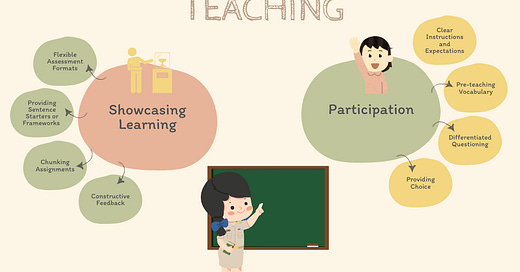Welcome back to my series on building a new Special Educational Needs (SEN) department from the ground up. In the first three articles, "The Unseen Demands", "The Blank Canvas" and “Unveiling the Learning Landscape” we explored the foundational challenges, exciting possibilities of starting anew, and identifying the needs of SEN students. This week, I want to shift our focus from the structural to the pedagogical, delving into the powerful impact of observant and responsive teaching practices.
One of the most enlightening experiences I've had in this journey has been observing lessons where, without any direct input from a SENCO (Special Educational Needs Coordinator) or formal SEND department, teachers intrinsically made thoughtful and effective provisions for students with additional needs. It's a testament to the power of skilled pedagogy and a deep understanding of one's students.
The Art of Unconscious Provision
I've witnessed lessons where, seemingly without explicit planning for SEND, teachers seamlessly wove in strategies that benefited every learner, especially those who might otherwise struggle. This wasn't about complex interventions; it was about fundamental teaching excellence:
Clarity and Repetition: Breaking down complex instructions, repeating key concepts in different ways, and using visual aids.
Varied Engagement: Offering multiple pathways for students to interact with the material – discussion, hands-on activities, individual reflection.
Purposeful Grouping: Strategically pairing students to leverage peer support and different ways of learning.
Checking for Understanding: Not just asking "Does anyone have questions?" but actively soliciting responses through mini-whiteboards, quick polls, or individual check-ins.
Positive Reinforcement: Celebrating effort and progress, fostering a safe environment for risk-taking and mistakes.
These weren't "SEN strategies" in isolation; they were simply good teaching. And their impact on students with additional needs was profound, allowing them to access the curriculum, participate meaningfully, and feel a sense of belonging.
Knowing Your Students: The Cornerstone of Effective Provision
What underpins this "unconscious provision" is a deep, empathetic understanding of each student. Before a SENCo even steps foot in the door, before formal assessments are made, teachers are the front-line experts on their students' strengths, challenges, interests, and anxieties.
Consider these questions:
Who thrives in group work, and who needs quiet individual reflection?
Who benefits from visual aids, and who learns best through auditory explanations?
Who struggles with processing speed, and who needs more time to formulate their thoughts?
What are the triggers for disengagement, and what sparks curiosity?
This intimate knowledge allows teachers to anticipate potential barriers and proactively adjust their approach, often without even realizing they are making a "SEND adjustment." It's about personalising the learning experience, not just for a designated group, but for every individual in the classroom.
Scaffolding for Success: Participation, Engagement, and Showcase
Once you know your students, the next crucial step is providing the right scaffolding to ensure they can not only participate but truly engage and demonstrate their learning. This isn't about doing the work for them; it's about providing the necessary support structure that allows them to reach higher.
1. Scaffolding Participation:
Clear Instructions & Expectations: Breaking down tasks into smaller, manageable steps. Using visual schedules or checklists.
Pre-teaching Vocabulary: Introducing key terms and concepts before the main lesson.
Differentiated Questioning: Posing questions at varying levels of complexity, allowing all students to contribute.
Providing Choice: Offering options for how students can access information or demonstrate understanding (eg: reading an article, watching a video, listening to an audio clip).
2. Scaffolding Engagement:
Varied Activities: Moving beyond traditional lecturing to incorporate debates, role-plays, practical experiments, and creative tasks.
Frequent Breaks: Recognising when students need a moment to re-focus or process information.
Sensory Input: Using multi-sensory approaches to make learning more tangible and memorable.
Building on Interests: Connecting learning to students' personal interests or real-world applications.
3. Scaffolding the Showcase of Learning:
Flexible Assessment Formats: Moving beyond written essays or timed exams. Allowing students to demonstrate understanding through presentations, artistic creations, oral explanations, diagrams, or practical demonstrations.
Providing Sentence Starters or Frameworks: Helping students structure their thoughts and articulate their understanding.
Chunking Assignments: Breaking down large projects into smaller, more manageable parts with clear deadlines.
Constructive Feedback: Focusing on specific areas for growth and providing clear next steps, rather than just a grade.
The Unseen Collaboration
While building a formal SEN department is critical for systemic support, policies, and specialist interventions, these observations remind us that the foundation of inclusive education often lies within the general classroom. The teachers who instinctively make these provisions are not just teaching subjects; they are teaching students. They are the "invisible hands" that nurture potential and ensure that every learner, regardless of their additional needs, has the opportunity to thrive.
As we continue to build our SEN department, this understanding will be paramount. Our goal is not to replace these incredible skills, but to enhance them, provide targeted support where needed, and champion the practices that make every classroom truly inclusive.
Next week, we'll delve into the crucial step of formalising this support, exploring how we draw up Individualized Education Plans (IEPs) and bring together the vital "Team Around the Child" – including teachers, parents, and specialists – to create a truly consultative and effective pathway for every student.





